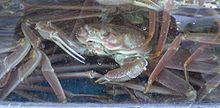- Chionoecetes
-
Chionoecetes 
Chionoecetes bairdi 
Chionoecetes opilio Scientific classification Kingdom: Animalia Phylum: Arthropoda Subphylum: Crustacea Class: Malacostraca Order: Decapoda Infraorder: Brachyura Family: Oregoniidae Genus: Chionoecetes
Krøyer, 1838Species See text
Chionoecetes is a genus of crabs that live in the northern Pacific and Atlantic Oceans.[1]
Other names for crabs in this genus include "queen crab" (in Canada) and "spider crab" – they are known by different names in different areas of the world. The generic name Chionoecetes means snow (χιών, chion) inhabitant (οιχητης, oiketes);[2] opilio means shepherd, and C. opilio is the primary species referred to as snow crab. Marketing strategies, however, employ snow crab for anything in the genus Chionoecetes.
Snow crab are caught as far north as the Arctic Ocean, from Newfoundland to Greenland and north of Norway in the Atlantic Ocean, and across the Pacific Ocean, including the Sea of Japan, the Bering Sea, the Gulf of Alaska, Norton Sound, and even as far south as California for Chionoecetes bairdi.
Fishing for opilio crab has been the focus of the second half of all six seasons of Deadliest Catch on the Discovery Channel. Fishing for bairdi crab is also occasionally seen, particularly in Seasons 3 and 6.[3]
Species
Seven extant species are currently recognised in the genus:[4]
- Chionoecetes angulatus Rathbun, 1893 – triangle tanner crab
- Chionoecetes bairdi Rathbun, 1893 – tanner crab or bairdi
- Chionoecetes elongatus Rathbun, 1925
- Chionoecetes japonicus Rathbun, 1932 – beni-zuwai crab
- Chionoecetes opilio (Fabricius, 1788) – snow crab or opilio
- Chionoecetes pacificus Sakai, 1978
- Chionoecetes tanneri Rathbun, 1893 – grooved tanner crab
External links
References
- ^ L. S. Jadamec, W. E. Donaldson & P. Cullenberg (1999). Biological Field Techniques for Chionoecetes crabs. University of Alaska Sea Grant College Program. Part 1 Part 2
- ^ Henrik Kröyer (1838). "Conspectus Crustaceorum Groenlandiae [Survey of the crustaceans of Greenlans]" (in Latin). Naturhistorisk Tidsskrift 2: 249–261. http://www.archive.org/details/naturhistoriskti02kjob.
- ^ Deadliest Catch official site
- ^ Peter K. L. Ng, Danièle Guinot & Peter J. F. Davie (2008). "Systema Brachyurorum: Part I. An annotated checklist of extant Brachyuran crabs of the world" (PDF). Raffles Bulletin of Zoology 17: 1–286. http://rmbr.nus.edu.sg/rbz/biblio/s17/s17rbz.pdf.
Categories:- Majoidea
- Edible crustaceans
Wikimedia Foundation. 2010.
